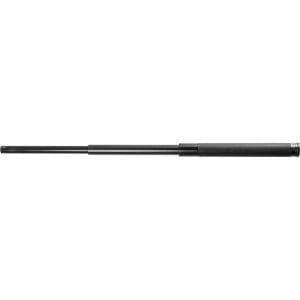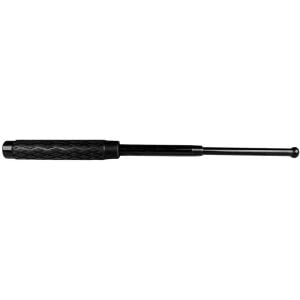Telescopic Baton Buyer’s Guide
Introduction: Why a Telescopic Baton?
When it comes to personal defense, telescopic batons (also called expandable or collapsible batons) offer a strong balance of reach, control, and intimidation.
Compact when closed but formidable when extended, they’re favored by law enforcement, security professionals, and civilians who want a non-lethal yet powerful self-defense tool.
If you’re new to this type of equipment, this guide will walk you through how batons work, what to look for, how to carry them legally, and tips for safe and effective use.
1. What Is a Telescopic Baton?
A telescopic baton consists of multiple metal shafts that collapse into each other for easy storage.
With a quick flick of the wrist, it extends to full length—typically 16 to 31 inches—and locks in place, giving you extended reach against an attacker.
Key Components
Handle/Grip: Usually textured or rubberized for control.
Middle Shaft(s): Connect the sections and provide balance.
Tip: The striking end, made of hardened steel or alloy.
When collapsed, a baton can fit easily in a belt holster, purse, or vehicle compartment.
2. Benefits of a Telescopic Baton
✅ Compact & Concealable: Folds down small for everyday carry.
✅ Strong Deterrent: The visible extension sound often stops a threat before contact.
✅ Non-Lethal: Designed to incapacitate, not cause lasting injury when used properly.
✅ Durable & Reusable: Built from tough materials like carbon steel or aerospace aluminum.
✅ Extended Reach: Keeps distance between you and the threat.
3. Types of Telescopic Batons
-
Telescopic Batons for Self Defense
Rubber Handle Push Button Baton Various Sizes
$32.30 – $40.80Price range: $32.30 through $40.80 Select options This product has multiple variants. The options may be chosen on the product page -
Telescopic Batons for Self Defense
Expandable Steel Batons w/Rubber Handle
$21.20 – $24.60Price range: $21.20 through $24.60 Select options This product has multiple variants. The options may be chosen on the product page -
Flashlight/Stun Batons
Twist of Fate – Extendable Stun Gun Baton with Flashlight
$49.00Original price was: $49.00.$41.65Current price is: $41.65. Add to cart -
Telescopic Batons for Self Defense
Telescopic Batons Sale 12 inch
$19.95Original price was: $19.95.$16.96Current price is: $16.96. Add to cart
Steel Batons
Pros: Maximum striking power and durability.
Cons: Heavier to carry; can corrode if not maintained.
Best for: Law enforcement, security, or those who prioritize strength over weight.
Aluminum or Alloy Batons
Pros: Lightweight and easy to handle.
Cons: Slightly less impact force.
Best for: Civilians or beginners seeking portability.
Friction-Lock vs. Push-Button (Automatic)
Friction-Lock: Extends manually with a flick; closed by striking tip on a hard surface.
Push-Button / Quick-Release: Opens or collapses at the press of a button; faster and easier to operate.
Best for: Those who want quick deployment or have limited hand strength.
4. Choosing the Right Baton Length
| Baton Length (Extended) | Ideal For | Pros | Notes |
|---|---|---|---|
| 16–18 inches | Compact EDC (Everyday Carry) | Lightweight, discreet | Shorter reach |
| 21–23 inches | Balanced option | Best mix of reach & portability | Most popular civilian size |
| 26–31 inches | Professional/security use | Maximum reach & power | Heavier, less discreet |
Pro Tip: Your height can guide your choice — shorter users often prefer 16–21″, taller users 23–26″.
5. Legal Considerations
Baton laws vary widely by state and city.
In some areas, possession is restricted to law enforcement, while others allow civilians to own and carry them openly or concealed.
Before buying:
Research local and state laws (search “baton laws in [your state]”).
Never carry into airports, schools, or government buildings.
Use strictly for self-defense situations, not intimidation or aggression. Disclaimer: This guide is for educational purposes only. Always verify local regulations before purchase or carry.
Disclaimer: This guide is for educational purposes only. Always verify local regulations before purchase or carry.
6. Training and Safe Handling
Even though a telescopic baton is easy to deploy, proper technique matters.
Grip: Hold firmly with dominant hand, thumb wrapped, elbow slightly bent.
Stance: Keep balanced, non-aggressive posture.
Strikes: Aim for large muscle groups (arms, thighs) — avoid head or spine.
Practice: Train with an inert or practice baton to build muscle memory.
Storage: Keep baton collapsed and secure when not in use.
Consider taking a baton or defensive tactics class if offered locally.
7. Maintenance Tips
Regular care ensures your baton deploys smoothly when needed.
Wipe down after each use or training session.
Lubricate joints lightly if friction-lock feels sticky.
Avoid dropping on hard surfaces unnecessarily (can dent shafts).
Inspect locks and tips periodically for wear or damage.
8. Recommended Accessories
Duty Holster or Belt Pouch – Keeps your baton accessible.
Grip Tape or Sleeve – Improves hold in wet conditions.
Training Baton – For safe practice.
Replacement Tips or End Caps – Extend product lifespan.
9. Summary: Confidence Through Preparedness
A telescopic baton offers practical, non-lethal protection for anyone serious about personal security.
With the right size, material, and a bit of training, it can give you confidence in uncertain situations — all while staying compact enough for daily carry.
Invest in quality. Train with purpose. Carry responsibly.
Don’t wait until it’s too late. Equip yourself with reliable, Self Defense Tools and take control of your personal safety.
All the products listed make great, low-cost gifts. Keeping you and your loved ones safe.




